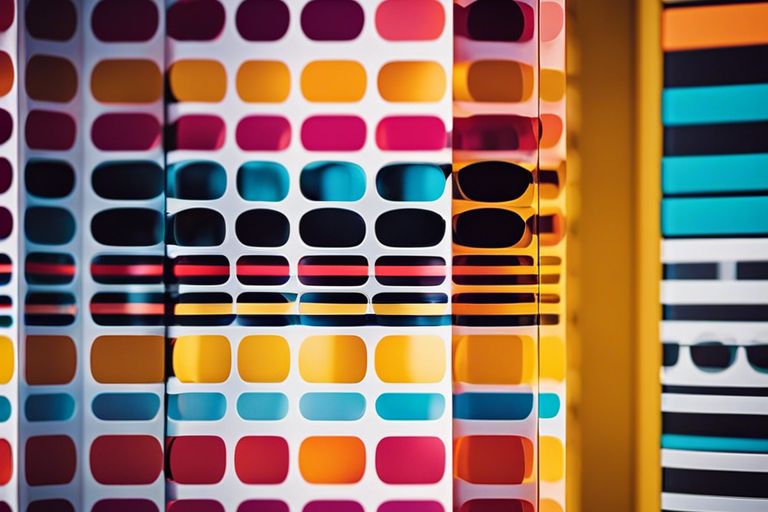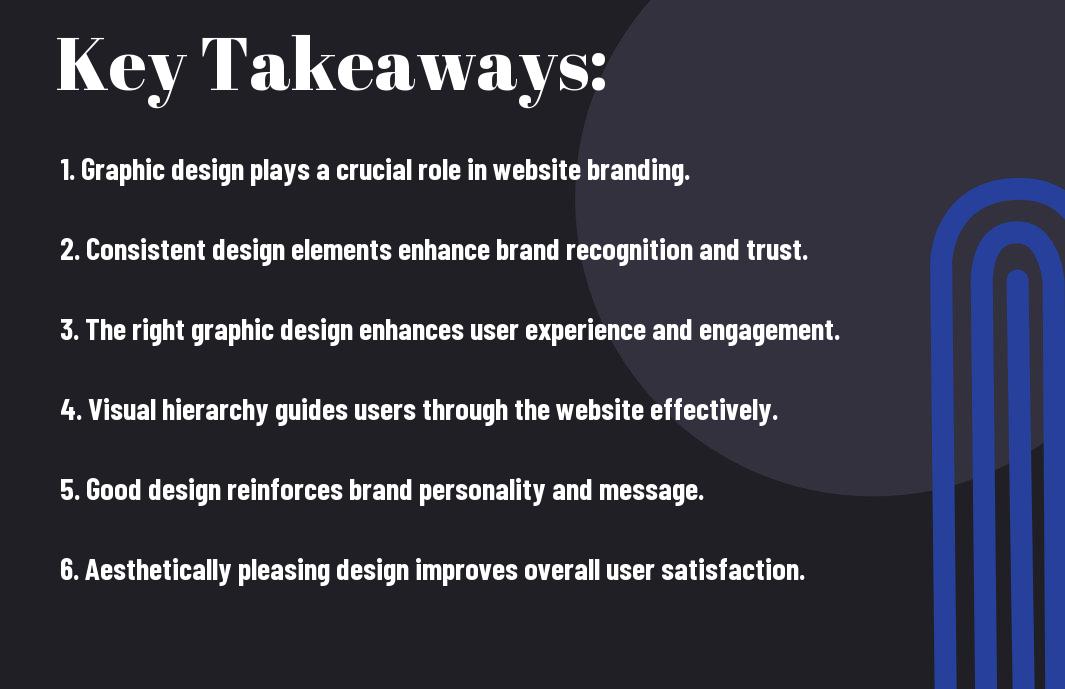As a website owner, you understand the importance of creating a strong and memorable brand, and the impact it has on your user experience. Graphic design plays a crucial role in establishing and maintaining your brand identity, while also enhancing the overall user experience on your website. The use of color, typography, and imagery all contribute to the aesthetics and functionality of your website, ultimately influencing how users perceive and interact with your brand. In this blog post, we will delve into the significance of graphic design in website branding and user experience, and offer insights into how you can leverage it to create a more impactful and engaging online presence. Stay tuned to discover the powerful impact of graphic design on your website’s success.
Key Takeaways:
- Graphic design plays a crucial role in creating a strong brand identity and shaping the overall user experience on a website.
- Consistent use of visual elements such as colors, typography, and imagery can reinforce the brand message and help users easily navigate a website.
- Effective graphic design can enhance the usability and functionality of a website, leading to improved user engagement and retention.
- Quality graphic design can build trust with users and convey professionalism, which can impact their perception of the brand and influence their purchasing decisions.
- It is important to prioritize accessibility in graphic design to ensure that all users, including those with disabilities, can have a positive experience on the website.


The Fundamentals of Graphic Design in Web Branding
The role of graphic design in website branding is The Integral Role of Graphic Design in Communication. It is an integral part of establishing a strong and memorable visual identity for your brand. When implemented effectively, graphic design can elevate your website’s user experience and create a lasting impression on your audience.
Elements of Effective Graphic Design
Graphic design encompasses a variety of elements that work together to create a cohesive and visually appealing website. From typography and color schemes to imagery and layout, each element plays a crucial role in capturing the attention of your audience and conveying your brand’s message.
Brand Identity and Visual Storytelling
Your brand’s visual identity is a key component of its overall identity. It goes beyond just a logo and includes the overall look and feel of your website, including the use of consistent visuals, messaging, and design elements. Visual storytelling through graphic design can evoke emotions and create a memorable experience for your audience, ultimately strengthening their connection to your brand.
Understanding the Impact of Graphic Design in Website Branding and User Experience
Graphic Design as a Tool for Enhancing User Experience
Not only does graphic design play a crucial role in creating a visually appealing website, but it also significantly impacts the overall user experience. When implemented effectively, graphic design can enhance usability, functionality, and user engagement on your website. In fact, the relationship between graphic design and user experience is closely intertwined, as mentioned in a thought-provoking article on UX Design vs. Graphic Design: Dueling for Design Dominance.
Navigational Elements and Layout
The strategic use of navigational elements and layout in graphic design can greatly influence how users interact with your website. Clear, intuitive navigation and well-organized layout contribute to a seamless browsing experience for your visitors. By carefully structuring your website’s layout and navigation, you can guide users through your content and help them quickly find what they are looking for. Your website’s navigational elements and layout should be user-friendly, logical, and consistent to create a positive user experience.
Color Theory and Typography
The selection of colors and typography in graphic design is fundamental in evoking certain emotions and perceptions from your website visitors. The strategic use of color palettes and typography can improve readability, create visual hierarchy, and convey brand personality. By understanding color theory and typography principles, you can effectively communicate your brand message and influence how users perceive your website. Consistent and purposeful use of colors and typography can evoke emotions, enhance brand recognition, and improve overall aesthetics of your website.
By leveraging graphic design elements such as navigational elements, layout, color theory, and typography, you can enhance the overall user experience on your website and leave a lasting impression on your visitors.Understanding the Impact of Graphic Design in Website Branding and User Experience
Now, let’s dive into some case studies that demonstrate how graphic design can truly transform user experience and brand identity. These case studies provide tangible evidence of the power of design in creating a memorable and effective online presence.
- Case Study 1: Redesigning a company’s website with a focus on intuitive navigation and eye-catching visuals led to a 40% increase in user engagement.
- Case Study 2: Implementing a cohesive visual identity across all digital platforms resulted in a 25% improvement in brand recognition.
- Case Study 3: Incorporating responsive design principles led to a 30% decrease in bounce rate and a 20% increase in mobile conversions.
Successful Branding Through Design
Successful Branding Through Design
Effective graphic design plays a critical role in successful branding. It allows you to communicate your brand’s message and differentiate yourself from competitors. By creating a visually appealing and cohesive brand identity, you can establish trust and credibility with your audience. It’s important to understand the psychological impact of design elements such as colors, typography, and imagery on consumer perceptions of your brand.
Design Pitfalls and Lessons Learned
Design Pitfalls and Lessons Learned
However, not all graphic design initiatives yield positive results. Ignoring user experience in favor of aesthetics can lead to frustrated visitors and high bounce rates. Additionally, inconsistent branding across different platforms can undermine the credibility of your brand. It’s essential to learn from these pitfalls and prioritize a user-centric approach to design, ensuring that every visual element serves a purpose and contributes to a positive user experience.
Optimizing Graphic Design for Different Platforms
Your website’s graphic design needs to be optimized for different platforms to ensure a consistent and impactful user experience across all devices. By adapting your graphic design to different platforms, you can effectively reach and engage with a wider audience, ultimately enhancing your brand’s online presence.
Responsive Design Considerations
When optimizing graphic design for different platforms, responsive design considerations play a crucial role. Responsive design ensures that your website adapts to the screen size and orientation of the device being used, providing a seamless and user-friendly experience for your visitors. By implementing responsive design elements, you can ensure that your graphic design remains consistent and visually appealing across various platforms, from desktop computers to smartphones and tablets.
Cross-Platform Branding Consistency
Another important aspect of optimizing graphic design for different platforms is maintaining brand consistency across all devices. Your brand’s visual identity, including logos, color schemes, and typography, should remain consistent regardless of the platform on which it is viewed. Consistent branding not only reinforces your brand identity but also fosters trust and recognition among your audience, regardless of their chosen device.
Understanding the Impact of Graphic Design in Website Branding and User Experience
To wrap up, it is crucial for you to recognize the significant impact that graphic design has on website branding and user experience. Your website’s visual elements play a key role in shaping your brand identity and making a lasting impression on your audience. The use of strategic graphic design can not only enhance the overall aesthetic appeal of your website, but also improve user engagement and navigation. By leveraging the power of graphic design, you can effectively communicate your brand message, build credibility, and ultimately create a seamless and enjoyable user experience. It’s essential to prioritize graphic design as a fundamental element of your website strategy in order to leave a memorable and positive impression on your visitors.
FAQ
Q: What is the impact of graphic design in website branding and user experience?
A: Graphic design plays a crucial role in shaping the perception of a website and its brand. It helps in creating a visually appealing and cohesive look that enhances user engagement and experience.
Q: How does graphic design contribute to brand recognition on a website?
A: Graphic design elements such as logos, color schemes, and typography help in establishing a strong brand identity on a website. Consistent use of these elements across the website creates brand recognition and strengthens brand recall among users.
Q: What are the key aspects of graphic design that impact user experience on a website?
A: Visual hierarchy, use of whitespace, intuitive navigation, and responsive design are some key aspects of graphic design that significantly impact user experience on a website. These elements contribute to ease of use and enable users to find and interact with content effortlessly.
Q: How does graphic design influence user engagement on a website?
A: Thoughtfully designed visuals, including images, icons, and infographics, capture users’ attention and encourage them to explore the website further. Engaging graphic design elements can lead to increased time spent on the website and higher interaction rates.
Q: What role does graphic design play in conveying the brand’s message and values on a website?
A: Through the use of visual elements, graphic design helps in conveying the brand’s message and values in a compelling manner. It enables the website to visually communicate the brand’s tone, personality, and story, thus creating a lasting impression on users.
